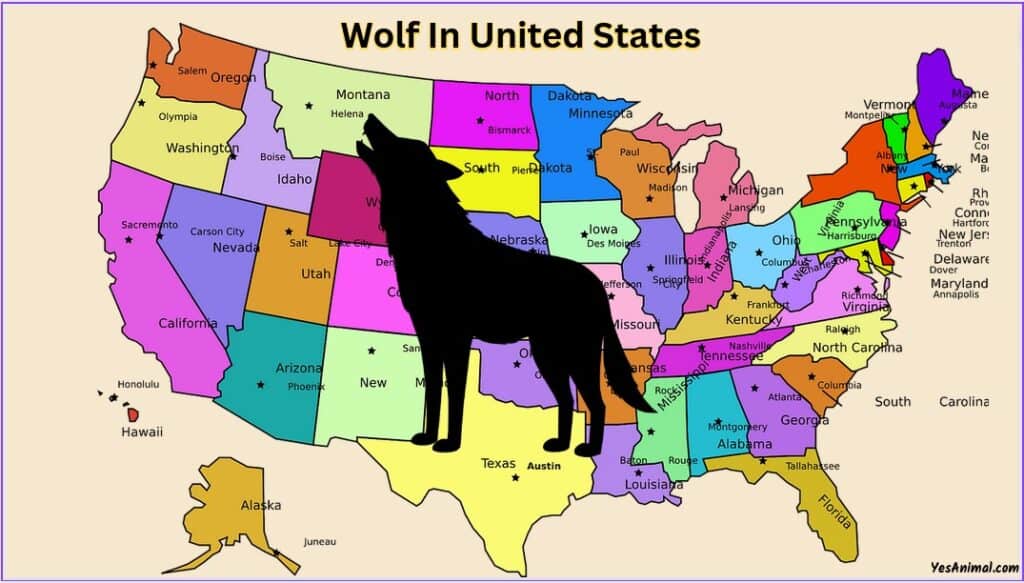Last Updated on November 27, 2023 by Amin Tawar

Only a few animals can compete with the wolf’s significance in USA’s history and culture. Since pre-historic times, wolves’ howl has been heard throughout the country’s states. But since a century back, especially after European colonization, wolf numbers have drastically reduced owing to extreme unregulated hunting, habitat destruction, and loss in prey numbers.
Today, various conservation groups and the U.S. Fish and Park have undertaken various initiatives to stabilize the wolf population across the country. And as a resident, it is pertinent that we understand this creature’s presence, significance, and history to help aid their conservation efforts.
Are There Wolves in US?
Yes, Currently, wolves still inhabit a few parts of the United States. But did you know, these creatures were extirpated from almost all the 48 lower states?
There are three subspecies of wolf found in the United States of America namely, gray wolf, red wolf, and Mexican wolf which is actually one of the gray wolf’s subspecies. Out of these, the gray wolf has a substantial population in the states and the rest two are rarely sighted.
Wolves by nature are very adaptable and therefore are found in a range of habitats including deserts, mountains, grasslands, and forests. They are also social animals and tend to roam and hunt in packs.
How Many Wolfs Are There In the USA?
There are about 14,000 to 17,000 wolves in the USA with the largest population occupied in Alaska. Since these creatures typically can survive in any habitat, they are found in southwestern states, the Great Lakes, and also the Rocky Mountains. In fact, only 13 states in the country have an established population of wolves. We cannot stress enough the nature of any and every wildlife’s numbers.
These numbers are expected to change as they depend on numerous factors like the availability of habitat, hunting regulations, human interactions, and conservation efforts.
Are Wolfs Endangered in The Us?

It all depends on the state and the type of wolf to know if they are endangered or not. Once added to the endangered list in 1974, gray wolves have since then been delisted in many states owing to the rise in their population. This includes states like Montana, Idaho, Wyoming, Michigan, and parts of Washington, and Oregon where Rocky Mountain gray wolves tend to live.
But the same cannot be said for the red wolf and the Mexican wolf which still are on the endangered list and can only be found in a few isolated regions.
How Did Wolfs Get to America?
Gray wolves across the Northern continent originated from Asia. About 700,000 years ago, gray wolves termed scientifically as Canis lupus crossed the Pleistocene land bridge that connected Alaska and Russia thereby connecting the two continents.
The availability of other large mammals like bison, and elk further helped wolves to thrive in various ecosystems across the continent. And soon, these creatures spread downwards and occupied almost all of the continent. As they established their territories across the continent, they not only became an integral part of the ecosystem but also became an important part of tribal people’s culture.
The red wolves however are native to the North American continent specifically the southeastern part of the United States. It is not clear how they came about but are generally considered as a separate species, a subspecies of the gray wolf or a coywolf.
Wolf Population in Us by State?
As mentioned before, only 13 states out of the historical range of 48 states are currently inhabited by wolves. But wolves typically have large territories that are spread out and may overlap more than a state.
That is why the wildlife biologists in the state group them into regional population groups which may include more than 2 or more states. Each state’s individual Fish and Wildlife Departments and Department of Natural Resources is responsible to control, monitor and maintain the wolf population in their respective states.
The top five spots for having the most population of wolves are taken by Alaska with a population of 7,000 to 10,000 individuals, Minnesota with 2,696 individuals, Idaho with 1,556 individuals, Wisconsin with 1,034 to 1,057 individuals, and Montana with 833 individuals.
Wolves are also hosted in other states like Michigan with 695 individuals, Wyoming with 327 individuals, Washington with 206 individuals, Oregon with 175 individuals, New Mexico with 112 individuals, Arizona with 84 individuals, California with 20 individuals, and North Carolina with 17 individuals.
Check Out Complete Guide On Wolf In North America
- Wolf In California
- Wolf In Colorado
- Wolf In Florida
- Wolf In Michigan
- Wolf In Montana
- Wolf In Texas
- Wolf In Yellowstone
- Wolf In Wisconsin
- Wolf In Utah
- Wolf In Oregon
- Wolf In New York
- Wolf In Minnesota
- Wolf In Virginia
- Wolf In Tennessee
- Wolf In Ohio
- Wolf In New Jersey
- Wolf In Missouri
- Wolf In Massachusetts
- Wolf In Illinois
- Wolf In Georgia
- Wolf In Arizona
- Wolf In Alaska
- Wolf In Oklahoma
- Wolf In Kentucky
- Wolf In Indiana
- Wolf In Canada
Can You Hunt Wolf in Us?
Hunting of gray wolves in most of the states in the country is illegal as wolves are protected under the endangered list. But recently in the last few years, some states have delisted these creatures, whereby they now come under the individual state’s authority.
These states then have developed and established hunting seasons for wolves based on conservation goals and population dynamics. For instance, Alaska is one such state where these majestic creatures were never listed. So here it is legal to hunt wolves provided you have a relevant hunting license.
For red and Mexican wolves, it is illegal to hunt them in every state they currently inhabit. But regardless of the state or region in which you live, if you spot any wolf behaving dangerously and predating on livestock, you can contact the local wildlife agency or the U.S. Fish and Wildlife Service who will come and take care of the situation.
Can You Own Wolf in Us?
In most states, it is illegal to own a wolf and more so as a pet. These are wild animals and cannot be trusted enough for domestication.
But some states do allow us to own them if we have a permit for ownership. It is however important to note that getting this permit is quite difficult due to the set of exceptions it is applicable to. Permits are usually provided for educational purposes, research purposes and rehabilitation purposes and never for personal purposes. To avail of one, look into each state’s wildlife agency department website and apply for the permit. Make sure you read the whole application requirements before moving towards wolf hunting in the state.
Conclusion
And that was everything you need to know about the Wolf In the US. I hope this article answered all your queries.
Thank You For Reading!
Our Source For This Guide